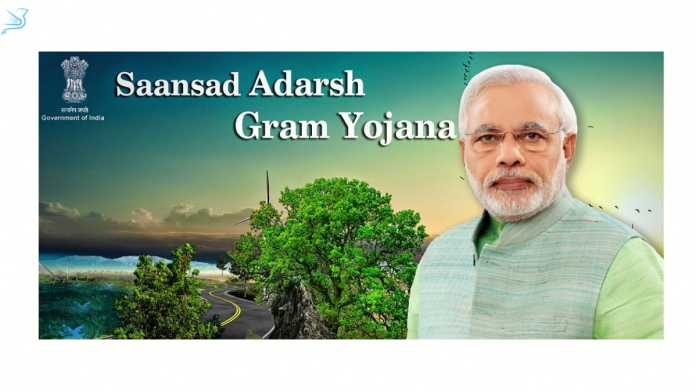Hello People!
In today’s blog we will learn about the Saansad Adarsh Gram Yojana (SAGY). The scheme was launched in 2014. Recently, the Union Minister for Rural Development, Sadhvi Niranjan Jyoti has informed in Rajya Sabha about the various steps taken by the government for implementation of the Saansad Adarsh Gram Yojana (SAGY)
We will discuss in detail about the scheme, its salient features, achievements and future goals.
Saansad Adarsh Gram Yojana
The scheme was launched in 2014 on the birth anniversary of Jai Prakash Narayan.
Under the Yojana, Members of Parliament (MPs) are responsible for developing the socio-economic and physical infrastructure of three Adarsh Grams by March 2019, of which one was to be achieved by 2016. Thereafter, five such Adarsh Grams (one per year) will be selected and developed by 2024.
Objectives
The main objectives of SAGY are:
- To initiate processes that will lead to the overall development of the identified Gram Panchayats.
- To foster the identified Adarsh Grams as schools of local development to train other Gram Panchayats.
- To establish models of local level development and effective local governance that may motivate and inspire neighbouring Gram Panchayats to learn and adapt.
How is a village selected?
- A Gram Panchayat would be the basic unit. It will have a population of 3000-5000 in plain areas and 1000-3000 in the hilly, tribal and difficult area.
- The MP would be free to identify a suitable Gram Panchayat to be developed as Adarsh Gram, other than his/her own village or that of his/her spouse.
- The MP will identify one Gram Panchayat to be taken up immediately, and two others to be taken up little later.
- Lok Sabha MP has to choose a Gram Panchayat from within his/her constituency and Rajya Sabha MP a Gram Panchayat from the rural area of a district of his/her choice in the State from which he/she is elected.
Activities in an Adarsh Gram
An Adarsh Gram should emerge from people’s common vision, utilizing their capacities and available resources with the MP, Gram Panchayat, civil society, and the government machinery assisting as needed. The major operations can still be identified in broad terms.
They would include:
SAGY Expected Outcomes
The broad outcome of the programme is to create local opportunities for employment and livelihood generation, while reducing distress migration for employment.
Ensuring complete freedom from bonded labour, child labour and manual scavenging.
Total registry of all births and deaths and ensuring a healthy male-female ratio. Promotion of social integration and harmony amongst all communities and ensuring social justice for all through locally managed fair and transparent grievance redressal mechanisms.
Establish a demonstration impact on other villages so that they too may emulate the model.
Steps taken for successful implementation of SAGY in adopted Gram Panchayats
- Under SAGY, the Ministry has compiled a list of 127 Central Sector and Centrally Sponsored Schemes, as well as 1806 State Schemes.
- SAGY is reviewed periodically by the National Level Committee (NLC) on Saansad Adarsh Gram Yojana (SAGY) headed by Secretary, Rural Development with representatives from 20 Ministries/Departments. The issues thus are identified and remedial action is initiated.
- An MP Dashboard is developed on SAGY website. The MP can verify and review the progress of the selected GP by logging in. The MP will have access to the MA score in order to analyze progress. Furthermore, the user’s concerns/opinions expressed in the comments section will be visible to the MP, District Collector, and Charge Officer, who will take appropriate action.
- The states have been asked to hold State Level Empowered Committee (SLEC) meetings, led by the Chief Secretary, to assess the implementation process and ensure that all state government departments are on the same page.
- For the newly elected MPs of the 17th Lok Sabha, the Ministry organized a SAGY orientation session. The Minister of Rural Development has also written to all Chief Ministers, requesting that they hold similar Orientation Workshops for MPs in their respective States/UTs.
List of few important adopting villages
Prime Minister Narendra Modi has adopted 6 villages as of now. In his first tenure between 2014 and 2019, the four villages were Jayapur, Nagepur, Kakrahia and Domari of Varanasi, Uttar Pradesh. Recently he adopted 2 more villages, Poore Bariyarpur and Parampur.
Sonia Gandhi adopted Udwa village in her Rae Bareli, Uttar Pradesh.
Rahul Gandhi adopted Deeh village in Amethi Uttar Pradesh.
Sachin Tendulkar adopted P.R Kandriga in Nellore district of Andhra Pradesh and Donja village in Maharashtra.
Jai Prakash Narayan
Jai Prakash Narayan was born in Uttar Pradesh on October 11, 1902. He was an Indian political leader and theorist. He is popularly known as Lok Nayak.
He joined the Indian National Congress in 1929 (Congress Party). He was sentenced to a year in prison in 1932 for his involvement in the Indian Civil Disobedience Movement against British authority.
In 1974, he issued a call for a peaceful “total revolution,” in which he urged students to rise up against corrupt political institutions, demand the closure of colleges and universities, and devote their time to rebuilding the country. It was this time in the history that he was popularly called “JP”
This movement resulted in the declaration of emergency and the victory of the “Janata Party,” which created the first non-Congress government in the country in March 1977.
In 1999, the Indian government posthumously gave him the Bharat Ratna, the country’s highest civilian award, as a tribute to this modern revolutionary.
With this we come to the end of this blog. We hope it was an interesting read for you all.
Do share your views in the comments below!




